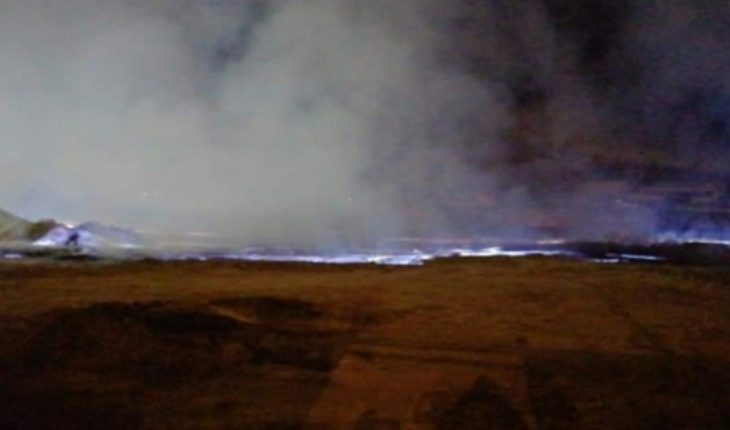Disasters can be caused by natural causes, human actions or chemical-industrial accidents. About natural disasters, such as earthquakes and tsunamis, volcanic eruptions and consequent environmental pollution, torrential rains and floods; and those caused by man-socio-organizationals , such as domestic violence, drug addiction, cyberattacks and terrorist-type actions can be “assumed under control” through various member agencies of the National System of Civil Protection, headed by Onemi.
However, disasters caused by chemical-industrial processes, such as the recent case of a landfill or sulphur tank fire, always turn out to be complicated. First, by its very nature, the product of the chemical combination of various elements or pure substances, often unspecified or accurately identified. Second, in our midst, at least, this type of emergency is usually not too frequent, without detracting from the greater or lesser latent risk depending on its magnitude and depending on the place of its occurrence. Third, its low frequency and the varied of its components in each case, prevents the Related Services from accumulating sufficient experience in this regard. Fourth, the administrator of these products usually does not always respect all the recommended safety measures, whether in plant their processing, storage, handling of loading /unloading products, including their transport. And fifth, the common citizens do not know, and if not, do not respect the prevention and safety signalling and labelling used to minimize the risks arising from a given chemical, as in this case, the existence of a toxic waste dump – sulphur-, above, very close to a populated sector.
But, to that point, we must add a problem of public and institutional information and communications; because when ignorance prevails during an emergency and collective panic reigns, the means of emergency communications are often saturated, even today, with all the technology available, on the irrational demand of them by the users and, which is repeated with major earthquakes; institutional blockade arises when ‘someone’ not linked to a given institution has the appropriate response to resolve a situation of emergency faced and is not heard for not belonging to the Institution or Service operating on the site of the event. Professional celo misunderstood, because information from a known source should not be disregarded, even if it is outside the System.
On 94, the Valparaiso Gasometer was suddenly engulfed in flames, with the consequent panic unleashed in the population, including the Emergency Services themselves. During a Provincial Technical Course of Fire Corps, in 1966!, a veteran UTFSM Engineer had explained to us that the Gasometers were not in greater danger to the population. Upon learning what was happening, I wanted to inform the Authorities what I knew about it, but it was impossible for me to access by saturating the telephone lines, both Services and radio stations. In the end, the Porteños were convinced that they had experienced the quasi-biggest tragedy of Valparaiso, about to disappear from the map.
Another, a ship approaching the port of Valparaiso and declared in emergency by fire of rolls of paper in its cellars, hermetically closed trying to drown the combustion process. I was initially and spontaneously commented with some fire friends on the need to ventilate the wineries as soon as i arrived in Puerto before attempting the extinction of the fire, given the high concentration of Carbon Dioxide (C02) and Carbon Monoxide (C0) accumulated, this latest, highly toxic gas.
However, in the meantime, with the intention of verifying the information received, a crew member and an expert (friend) tried to enter the hold without proper protection and the seaman died and the other, falling by suffocation, fell metal ladder down, seriously injuring the spine. On that occasion, initially, I didn’t try to give any notice for not appearing as meddling. After what happened to my friend, I swore never to shut up again at the possibility of avoiding unnecessary risks or deaths.
The experience, in this specific case, arises responding to an emergency, this time a truck loaded with a couple of drums containing sulfur in bulk, one of them in slow combustion, plus a pair of cylinders of Freon Gas 12. The driver – disappeared -, before tried to turn off the sulphur with a water extinguisher, immediately generating fumes from a yellow-green gas with an intense unpleasant and spicy smell. The color and rotten egg smell of the gases produced by sulfur, according to a label readable on one side of the drum, made us go back to analyze the situation, deciding to avoid pouring water on it, as a precautionary measure, since we did understand that its combination would generate an increase in gases not only toxic, but also corrosive and, observable already in our locker room, splashed at the start of the actions. A comrade firefighter, student of today PUCV, brought us the solution, after consulting in the Chemistry Laboratory: control and put out the fire applying dry earth. And… from where? Then breaking and extracting with shovels earthen cakes with grass from the gardens of a public square! That was our experience, in the late 1960s, and it’s the information we communicated in a timely manner. Foam?
The content poured into this opinion column is the sole responsibility of its author, and does not necessarily reflect the editorial line or position of El Mostrador.





